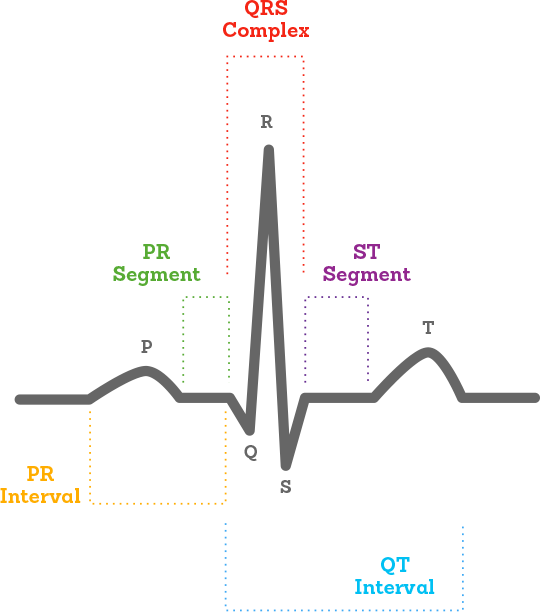What is an ECG?
Also known as an electrocardiogram or an EKG, an ECG is a test that detects and records the strength and timing of the electrical activity in your heart. This information is recorded on a graph that shows each phase of the electrical signal as it travels through your heart.
vs
An ECG (electrocardiogram) records the electrical activity of your heart in the remaining place. It provides information about your heart rate and rhythm, and shows that the increase in heart increases due to high blood pressure (hypertension) or previous cardiac attacks (myocardial infarction).


Also known as an electrocardiogram or an EKG, an ECG is a test that detects and records the strength and timing of the electrical activity in your heart. This information is recorded on a graph that shows each phase of the electrical signal as it travels through your heart.
The electrical signal begins in the sinoatrial node (1) which is located in the right atrium and travels to the right and left atria, causing them to contract and pump blood into the ventricles. This electrical signal is recorded as the P wave on the ECG. The PR Interval is the time, in seconds, from the beginning of the P wave to the beginning of the QRS complex.
The electrical signal passes from the atria to the ventricles through the atrioventricular (AV) node (2). The signal slows down as it passes through this node, allowing the ventricles to fill with blood. This slowing signal appears as a flat line on the ECG between the end of the P wave and the beginning of the Q wave. The PR segment represents the electrical conduction through the atria and the delay of the electrical impulse in the atrioventricular node.
After the signal leaves the AV node it travels along a pathway called the bundle of His (3) and into the right and left bundle branches (4, 5). The signal travels across the heart’s ventricles causing them to contract, pumping blood to the lungs and the body. This signal is recorded as the QRS waves on the ECG. Because these waves occur in rapid succession they are usually considered together as the QRS complex.
The ventricles then recover to their normal electrical state, shown as the T wave. The muscles relax and stop contracting, allowing the atria to fill with blood and the entire process repeats with each heartbeat. The ST segment connects the QRS complex and the T wave and represents the beginning of the electrical recovery of the ventricles.
The QT interval represents the time during which the ventricles are stimulated and recover after the stimulation. This interval shortens at a faster heart rate and lengthens at a slower heart rate.
When are ECGs needed?
In some cases, this may be important to get the test. If you have risk factors for more blood pressure or heart problems such as chest pain, breathing problem, irregular heart beat, or heart beat, you may have an ECG. You may need testing for screening or professional requirements, or if you have a personal or family history of heart disease, diabetes or other risks and you want to start exercising.
How should you protect your heart?
These steps can help protect your heart, whether you have heart disease or just want to prevent it.
Know your risks. Talk to your health care provider. Your risk of heart disease depends on many things, such as your age, sex, ethnicity, cholesterol, blood pressure, and if you smoke or have diabetes. Use the risk assessment test at
Lower your risks. The best ways to lower your risk of heart disease are to:
- Be aware of your risk factors.
- Know and control your blood cholesterol.
- Be smoke-free.
- Be physically active.
- Know and control your blood pressure.
- Eat a healthy diet that is high in fibre, lower in fat, especially saturated and trans fats, lower in sodium, includes lots of fruit and vegetables, and includes portions of food that are in line with your level of physical activity.
- Achieve and maintain a healthy weight.
- Manage your diabetes.
- Limit alcohol use.
- Reduce stress.
- Visit your health care provider regularly and follow your health care provider’s advice.
Test your blood pressure, blood cholesterol and blood sugar according to your health care provider’s recommendations. These tests prove to help in measuring your risk of developing heart disease.
Reasons Behind
Blood pressure. You should test at least once a year using blood pressure cough. If you have been diagnosed with high blood pressure (or other related conditions), your health care provider will recommend that your blood pressure will be checked more frequently. Make sure to check your blood pressure often by asking your health care provider.
Cholesterol If you are a male and you have a blood test for cholesterol after more than 40 years of age and more than 50 or menopause, then you have heart disease, stroke, diabetes or high blood pressure, waist 102 cm. (40 inches) for men or 88 cm (35 inches) For women, you have a family history of heart disease or stroke. Your health care provider can advise how often you should check your cholesterol.
Blood sugar If you are over 40, you should test blood once every three years to measure your blood sugar (glucose). Very glucose can damage your blood vessels. If you have diabetes risk factors or are pregnant, then your blood sugar levels should be tested. Talk to your health care provider whether you need blood sugar or not.
If your blood pressure, blood cholesterol, or blood sugar is very high, reduce it to work with your health care provider. Most people reduce cholesterol and blood pressure and manage diabetes with lifestyle changes and medication. This reduces the risk of heart attack and stroke.
































0 Comments: